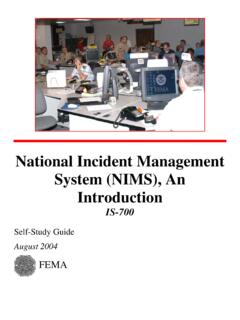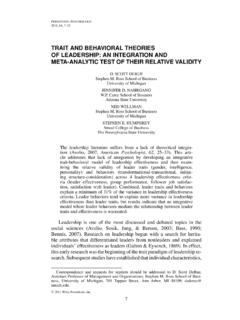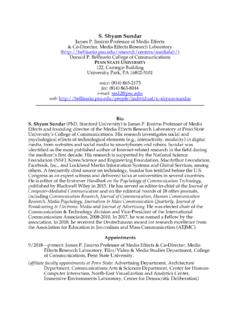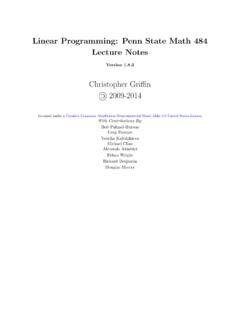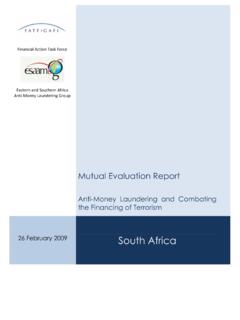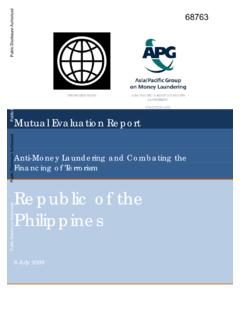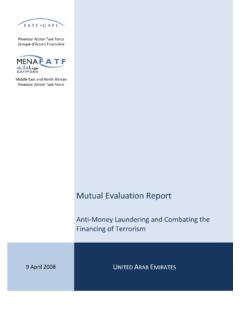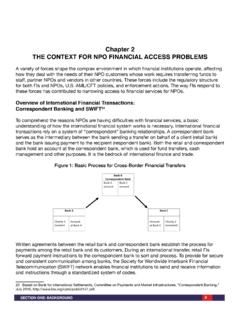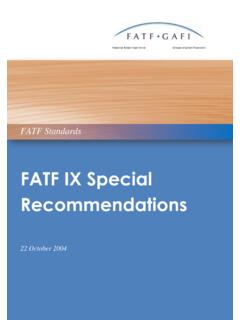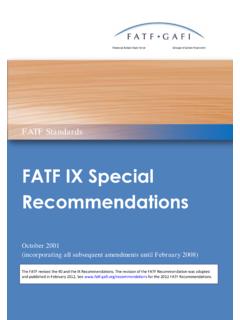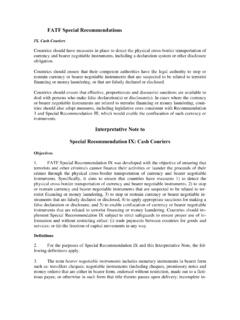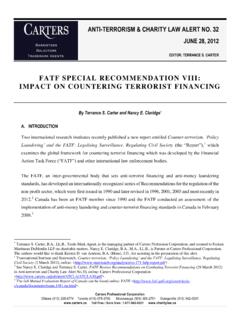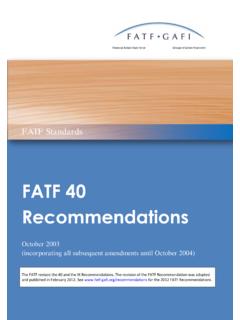Transcription of U.S. Legal Profession Efforts to Combat Money Laundering ...
1 NEW YOrK LaW sChOOL LaW rEViEW VOLUME 59 | 2014/15. voLUMe 59 | 2014/15. LAUREL S. TERRY. Legal Profession E orts to Combat Money Laundering and Terrorist financing 59 SCH. L. REV. 487 (2014 2015). ABOUT THE AUTHOR: Laurel S. Terry is a professor of law at Penn State's Dickinson Law, which is located in Carlisle, PA and is the older of Penn State's two law schools. She would like to thank Jack Sahl and Kevin Shepherd for comments on this article, and Kevin Shepherd, Duncan Osborne, Margaret Drent, Victoria Rees, and Simon Chester for their assistance in preparing for the FATF symposium held at New York Law School on April 25, 2014. 487. Legal Profession eFForTS To Combat Money Laundering & TerrorIST financing N. New York Law School's April 2014 symposium entitled Combating Threats to the International Financial System: The Financial Action Task Force was the first law school symposium to address the impact of the Financial Action Task Force (FATF) on the Legal For this reason, I was pleased to have been invited to participate and contribute this article discussing the efforts by the Legal Profession to Combat Money Laundering and terrorist financing .
2 Part I of this article provides a brief overview of the FATF. Part II explains that Money Laundering and terrorist financing are federal crimes to which lawyers are subject. Part III addresses the Legal Profession 's efforts to Combat Money Laundering and terrorist financing by educating lawyers on how to avoid unwitting involvement. This section describes the educational efforts to date, explains why additional efforts are warranted, and offers suggestions for further steps that might be undertaken. The article concludes by noting that, while progress has been made, there is still work to be done to educate lawyers about how to avoid unwitting involvement in Money Laundering and terrorist financing schemes. i. finanCiaL aCtiOn tasK fOrCE baCKgrOUnd Established in 1989, the FATF is an intergovernmental organization whose objectives include combating Money Laundering , terrorist financing and other related threats to the integrity of the international financial system.
3 2 Although the FATF is comprised of only thirty-four members and two regional associations, it has a number of affiliates that collectively generate a worldwide The United States is a founding member of the FATF and considers the FATF to be a critical part of efforts to Combat Money Laundering and terrorist 1. New York Law School Law Review Symposium: Combating Threats to the International Financial System: The Financial Action Task Force (Apr. 25, 2014) [hereinafter New York Law School FATF. Symposium], available at 2. Who We Are, FIN. ACTION TASK FORCE, (last visited Apr. 10, 2015). When the FATF was established in 1989, its focus was on Money Laundering . See id. After the September 11, 2011 attacks, the Financial Action Task Force (FATF) expanded its mission to include combating terrorist financing . See History of the FATF, FIN. ACTION TASK FORCE, http://www. (last visited Apr. 10, 2015). 3. Members and Observers, FIN.
4 ACTION TASK FORCE, membersandobservers/ (last visited Apr. 10, 2015). In addition to the thirty-six members, the FATF has eight Associate Members, including the Asia/Pacific Group on Money Laundering (APG); the Caribbean Financial Action Task Force (CFATF); the Council of Europe's Committee of Experts on the Evaluation of Anti- Money Laundering Measure and the financing of Terrorism (MONEYVAL);. the Eurasian Group (EAG); the Eastern and Southern Africa Anti- Money Laundering Group (ESAAMLG); the Financial Action Task Force on Money Laundering in South America (GAFISUD);. the Inter-Governmental Action Group against Money Laundering in West Africa (GIABA); and the Middle East and North Africa Financial Action Task Force (MENAFATF). Id. There are also a number of entities that are FATF Observers, such as The World Bank, the African Development Bank, the Asian Development Bank, and the European Central Bank (ECB). Id. 4. See, , Michael Rosen, Policy Advisor, Dep't of the Treasury, Remarks at New York Law School Law Review Symposium: Combating Threats to the International Financial System: The Financial Action Task Force Symposium (Apr.)
5 25, 2014), available at 488. NEW YORK LAW SCHOOL LAW REVIEW VOLUME 59 | 2014/15. One of the primary means by which the FATF seeks to accomplish these goals is by having its members agree to implement the FATF For many years, these recommendations were known as the 40+9 recommendations ,6 but they were reformulated in February 2012 and are now known as either the FATF. Forty recommendations or the FATF recommendations ( recommendations ).7. (explaining the importance of the FATF to the United States); Press Release, United Nations Office on Drugs & Crime (Oct. 25, 2011) (estimating that criminals may have laundered US$ trillion in 2009), available at The founding members of the FATF were the countries that comprised the G7 Summit in 1989: Canada, France, West Germany, Italy, Japan, the United Kingdom, and the United States, along with the president of the European Commission. See History of the FATF, FIN. ACTION TASK FORCE, (last visited Apr.
6 10, 2015); About the G8, DEP'T STATE, (last visited Apr. 10, 2015) ( During the 1970s, the United States, France, the United Kingdom, Germany, Japan, and Italy formed the Group of Six (G6) as an informal grouping of advanced industrialized economies that would meet annually to discuss matters of political and economic significance. Canada was added in 1976 to form the Group of 7 (G7). ). 5. See infra notes 8 9 and accompanying text. 6. See FIN. ACTION TASK FORCE, FATF FORTY recommendations (Oct. 2003), available at http://www. ;. FIN. ACTION TASK FORCE, ix special recommendations ON TERRORIST financing (Oct. 2001), available at IX%20 special %20 recommendations %20and%20IN% The original Forty recommendations date from 1990 and were amended in 1996. FIN. ACTION TASK FORCE, FATF FORTY recommendations . 2 (Oct. 2003), available at -%2040%20 recommendations % In 2001, soon after the September 11, 2001 attacks, the FATF added eight special recommendations to address terrorist financing .
7 FIN. ACTION TASK FORCE, ix special recommendations ON TERRORIST financing 88 (Oct. 2001), available at http://www. fatf-gaf /fatf/documents/reports/FATF %20 Standards%20-%20I X%20 special %20. recommendations %20and%20IN% In 2003, the FATF amended the Forty recommendations by, inter alia, adding the provisions to address gatekeepers other than financial institutions. In 2004, the FATF adopted a ninth special Recommendation. See FIN. ACTION TASK FORCE, THE FATF. recommendations 7 (Feb. 15, 2012) [hereinafter 2012 recommendations ], available at http://www. Collectively these recommendations were known as the FATF 40+9 recommendations . See, , Kevin L. Shepherd, The Gatekeeper Initiative and the Risk-Based Approach to Client Due Diligence: The Imperative for Voluntary Good Practices Guidance for Lawyers, J. PROF. LAW., 2010, at 88 [hereinafter Shepherd RBA]. (referring to the 40+9 recommendations ). 7. 2012 recommendations , supra note 6.
8 The 2012 revisions consolidated, reorganized, and renumbered the existing recommendations , which had been amended over a series of years. See id. at 4 5. As the introduction explains: The revisions address new and emerging threats, clarify and strengthen many of the existing obligations, while maintaining the necessary stability and rigour in the recommendations . The FATF Standards have also been revised to strengthen the requirements for higher risk situations, and to allow countries to take a more focused approach in areas where high risks remain or implementation could be enhanced. Id. at 8. 489. Legal Profession effortS to Combat Money Laundering & terroriSt financing N. Although the recommendations do not have the force of law,8 FATF members have agreed that the failure to implement them is grounds for expulsion from the Despite the soft-law nature of the recommendations , they are extremely influential because it is unlikely that countries such as the United States would want to be excluded from the FATF, which is a powerful tool in the fight against Money Laundering and terrorist FATF members evaluate their compliance with the recommendations through a mutual evaluation The United States has undergone three Mutual Evaluations, the most recent in June 2006,12 and is scheduled to undergo the on-site visit for its Fourth Mutual Evaluation in early 2016, with the FATF Plenary Discussion tentatively scheduled for October In 2013, FATF members agreed that during the fourth round of mutual evaluations, efforts would be made to measure not just technical compliance with the recommendations .
9 But also the effectiveness . of a country's 8. See Laurel S. Terry, An Introduction to the Financial Action Task Force and Its 2008 Lawyer Guidance, J. PROF. LAW., 2010, at 6 7. 9. See FIN. ACTION TASK FORCE, FATF MEMBERSHIP POLICY (Feb. 29, 2008), available at http://www. FBDFF0AE969F. Step 2(c) states: The overall mutual evaluation needs to be regarded as satisfactory, and in particular the level of compliance for the recommendations dealing with the Money Laundering and terrorist financing offences ( & ), freezing and confiscation ( & ), customer due diligence ( ), record-keeping ( ), suspicious transaction reporting ( & ), financial sector supervision ( ), and international co-operation ( , , , & ) need to be acceptable. Id. 10. See Rosen, supra note 4. 11. Mutual Evaluations, FIN. ACTION TASK FORCE, (last visited Apr. 10, 2015) ( The FATF conducts peer reviews of each member on an ongoing basis to assess levels of implementation of the FATF recommendations , providing an in-depth description and analysis of each country's system for preventing criminal abuse of the financial system.)
10 12. See FIN. ACTION TASK FORCE, THIRD MUTUAL EVALUATION REPORT ON ANTI- Money Laundering . AND COMBATING THE financing OF TERRORISM, UNITED STATES OF AMERICA (June 23, 2006). [hereinafter THIRD MUTUAL EVALUATION], available at documents/reports/mer/MER%20US% 13. See FIN. ACTION TASK FORCE, GLOBAL ASSESSMENTS CALENDAR (Nov. 6, 2014), available at http://. (listing the schedule for assessments under the 2013 methodology in Annex 1). This date already has been changed once and is subject to further change. 14. Procedures for the FATF Fourth Round of AML/CFT Mutual Evaluations, FIN. ACTION TASK FORCE, http://. (last visited Apr. 10, 2015) ( The scope of the evaluations will involve two inter-related components for technical compliance and effectiveness. The technical compliance component will assess whether the necessary laws, regulations or other required measures are in force and effect, and whether the supporting anti- Money Laundering and counter-terrorist financing (AML/CFT) institutional framework is in place.)
